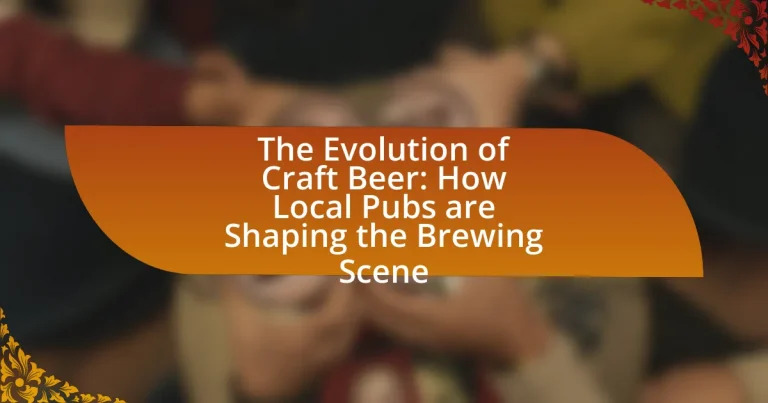The article examines the evolution of craft beer, highlighting the significant role local pubs play in shaping the brewing scene. It traces the origins of the craft beer movement from the late 20th century, noting the rise of microbreweries and the increasing consumer preference for artisanal products. Key events, such as the legalization of homebrewing and the establishment of brewpubs, are discussed as pivotal moments in the industry’s growth. The article also addresses the challenges faced by craft breweries, including competition from larger beer companies and regulatory hurdles, while emphasizing the importance of local pubs in promoting community engagement and supporting local breweries through curated selections and events. Future trends in sustainability and technology’s impact on the craft beer industry are also explored.

What is the Evolution of Craft Beer?
The evolution of craft beer began in the late 20th century as a response to the dominance of mass-produced lagers, with the first modern craft breweries emerging in the United States during the 1970s. This movement was characterized by a focus on quality, flavor, and traditional brewing methods, leading to a significant increase in the number of microbreweries and brewpubs. By 2020, the Brewers Association reported over 8,000 craft breweries in the U.S., showcasing the rapid growth and popularity of craft beer. This evolution has been shaped by local pubs that foster community engagement and support for small-scale brewers, further enhancing the diversity and innovation within the craft beer industry.
How has the craft beer movement developed over the years?
The craft beer movement has developed significantly since its inception in the late 20th century, evolving from a niche market to a mainstream industry. Initially, in the 1970s and 1980s, the movement began with a handful of microbreweries in the United States, driven by a desire for diverse flavors and local production. By 2020, the Brewers Association reported over 8,000 craft breweries operating in the U.S., reflecting a dramatic increase in consumer interest and market share. This growth has been fueled by changing consumer preferences towards artisanal products, local sourcing, and unique brewing techniques, leading to a vibrant craft beer culture that emphasizes community and innovation.
What key events have influenced the growth of craft beer?
The growth of craft beer has been significantly influenced by several key events, including the legalization of homebrewing in the United States in 1978, which allowed individuals to experiment with brewing and led to the establishment of numerous microbreweries. The American Homebrewers Association’s formation in 1978 also played a crucial role in promoting craft beer culture. Additionally, the rise of the craft beer movement in the 1990s, marked by the opening of the first brewpubs and the increasing popularity of beer festivals, further propelled the industry. By 2020, the Brewers Association reported over 8,000 craft breweries in the U.S., showcasing the substantial impact of these events on the craft beer landscape.
How have consumer preferences shifted towards craft beer?
Consumer preferences have shifted towards craft beer due to a growing demand for unique flavors and local production. This trend is evidenced by the increase in craft breweries, which rose from approximately 1,500 in 2000 to over 8,000 by 2020 in the United States, reflecting a significant consumer interest in artisanal products. Additionally, surveys indicate that 70% of consumers prefer craft beer for its variety and quality compared to mass-produced options, highlighting a clear shift towards supporting local businesses and seeking distinctive drinking experiences.
Why are local pubs significant in the craft beer scene?
Local pubs are significant in the craft beer scene because they serve as vital community hubs that promote local breweries and foster a culture of craft beer appreciation. These establishments often feature a rotating selection of local craft beers, allowing patrons to discover and support nearby breweries, which enhances the local economy. According to the Brewers Association, in 2022, 23% of craft breweries reported that local pubs were their primary sales channel, highlighting their role in connecting consumers with craft beer. Additionally, local pubs frequently host events, tastings, and educational sessions that engage the community and cultivate a deeper understanding of craft beer, further solidifying their importance in the craft beer landscape.
What role do local pubs play in promoting craft breweries?
Local pubs play a crucial role in promoting craft breweries by serving as primary venues for showcasing their beers. These establishments often feature a rotating selection of local craft brews, providing exposure to a diverse range of flavors and styles that attract customers. According to the Brewers Association, local pubs account for a significant percentage of craft beer sales, which helps to build brand recognition and loyalty for emerging breweries. Additionally, pubs frequently host events such as tap takeovers and beer tastings, creating opportunities for direct interaction between brewers and consumers, further enhancing community engagement and support for local craft beer culture.
How do local pubs contribute to community engagement with craft beer?
Local pubs contribute to community engagement with craft beer by serving as social hubs that foster connections among residents and promote local breweries. These establishments often host events such as beer tastings, brewery nights, and community gatherings, which encourage patrons to explore and appreciate craft beer offerings. According to the Brewers Association, local breweries and pubs create a sense of place and identity, enhancing community ties and supporting local economies. By featuring a rotating selection of craft beers from nearby breweries, local pubs not only showcase regional flavors but also educate customers about the brewing process and the stories behind each beer, further deepening community involvement and appreciation for craft beer culture.
What challenges does the craft beer industry face today?
The craft beer industry faces significant challenges today, including increased competition, rising ingredient costs, and regulatory hurdles. Increased competition arises from both the growing number of craft breweries and the expansion of large beer corporations into the craft market, which can dilute market share for smaller brewers. Rising ingredient costs, particularly for hops and malt, have been driven by supply chain disruptions and increased demand, impacting profit margins. Regulatory hurdles, such as complex licensing requirements and varying state laws, complicate operations for craft breweries, making it difficult to navigate compliance and expand distribution. These factors collectively threaten the sustainability and growth of the craft beer sector.
How do regulations impact local breweries and pubs?
Regulations significantly impact local breweries and pubs by dictating operational standards, licensing requirements, and taxation policies. These regulations can create barriers to entry for new breweries, as they often require extensive permits and compliance with health and safety codes. For instance, in the United States, the Alcohol and Tobacco Tax and Trade Bureau (TTB) enforces strict guidelines that breweries must follow, which can include everything from labeling to production limits. Additionally, local zoning laws can restrict where breweries and pubs can operate, affecting their accessibility and market reach. According to the Brewers Association, regulatory challenges can hinder growth, with 40% of small breweries citing compliance costs as a major concern. Thus, while regulations aim to ensure safety and fairness, they can also pose significant challenges for local breweries and pubs in their operational and financial viability.
What competition do craft breweries face from larger beer companies?
Craft breweries face significant competition from larger beer companies primarily through market dominance and distribution capabilities. Larger companies, such as Anheuser-Busch and Molson Coors, control a substantial share of the beer market, which allows them to leverage economies of scale, resulting in lower production costs and competitive pricing. This pricing strategy can make it challenging for craft breweries to compete on price, as they often have higher production costs due to smaller batch sizes and premium ingredients. Additionally, larger companies have extensive distribution networks that enable them to place their products in a wide range of retail outlets, making it difficult for craft breweries to gain shelf space and visibility. According to the Brewers Association, as of 2021, craft breweries represented only 23.1% of the overall beer market by volume, highlighting the competitive pressure they face from these larger entities.

How are Local Pubs Shaping the Brewing Scene?
Local pubs are significantly shaping the brewing scene by serving as incubators for craft beer innovation and community engagement. These establishments often collaborate with local breweries to offer unique, small-batch beers that reflect regional tastes and preferences, fostering a culture of experimentation. For instance, according to the Brewers Association, over 80% of craft breweries in the United States are small, independent operations that frequently partner with local pubs to reach consumers directly. This collaboration not only enhances the visibility of craft beers but also encourages patrons to explore diverse flavors and styles, ultimately driving demand for locally produced brews.
What unique offerings do local pubs provide for craft beer enthusiasts?
Local pubs provide craft beer enthusiasts with unique offerings such as exclusive local brews, rotating taps featuring seasonal selections, and curated tasting events. These establishments often collaborate with nearby breweries to create limited-edition beers that reflect regional flavors, enhancing the local craft beer culture. Additionally, many pubs host beer tastings and educational events, allowing patrons to learn about brewing techniques and flavor profiles directly from brewers. This direct engagement fosters a community around craft beer, making local pubs essential in shaping the evolving brewing scene.
How do local pubs curate their craft beer selections?
Local pubs curate their craft beer selections by focusing on regional breweries, seasonal offerings, and customer preferences. They often establish relationships with local brewers to feature unique and limited-edition beers, which enhances community engagement and supports local economies. Additionally, many pubs conduct surveys or gather feedback from patrons to understand their tastes, allowing them to adjust their selections accordingly. This approach not only reflects current trends in the craft beer market but also fosters a sense of local identity and pride among customers.
What events do local pubs host to promote craft beer culture?
Local pubs host a variety of events to promote craft beer culture, including beer tastings, brewery tap takeovers, and craft beer festivals. These events allow patrons to sample a wide range of craft beers, often featuring local breweries, which fosters community engagement and supports local businesses. For instance, beer tastings typically involve guided sessions where customers learn about different beer styles, brewing techniques, and flavor profiles, enhancing their appreciation for craft beer. Additionally, brewery tap takeovers showcase a specific brewery’s offerings, providing a platform for brewers to connect directly with consumers. Craft beer festivals, often organized by local pubs, bring together multiple breweries and beer enthusiasts, creating a vibrant atmosphere that celebrates craft beer diversity and innovation.
How do local pubs influence consumer trends in craft beer?
Local pubs significantly influence consumer trends in craft beer by serving as community hubs that promote local breweries and unique beer offerings. These establishments often curate their beer selections to highlight regional craft breweries, which encourages patrons to explore and support local products. According to a study by the Brewers Association, 75% of craft beer drinkers prefer to purchase beer from local breweries, demonstrating the impact of local pubs in shaping consumer preferences. Additionally, local pubs frequently host events such as beer tastings and brewery nights, which educate consumers about craft beer styles and brewing processes, further driving interest and demand for craft beer.
What impact do local pubs have on the popularity of specific beer styles?
Local pubs significantly influence the popularity of specific beer styles by serving as community hubs where patrons can discover and engage with diverse offerings. These establishments often curate their beer selections to highlight local breweries and trending styles, which fosters a direct connection between consumers and craft beer culture. For instance, a study by the Brewers Association indicates that local pubs that feature rotating taps of seasonal or limited-edition beers can drive consumer interest and increase sales of those specific styles. Additionally, local pubs frequently host events such as beer tastings and brewery nights, which educate patrons about different beer styles and encourage them to try new options, further enhancing the popularity of those styles within the community.
How do local pubs educate consumers about craft beer?
Local pubs educate consumers about craft beer through tastings, workshops, and informative menus. These establishments often host events where patrons can sample various craft beers, allowing them to experience different styles and flavors firsthand. Additionally, many pubs provide educational materials, such as detailed descriptions of the brewing process and the ingredients used, which enhances consumer knowledge. Research indicates that interactive experiences, like brewery tours and meet-the-brewer events, significantly increase consumer engagement and understanding of craft beer, fostering a deeper appreciation for the product.
What partnerships exist between local pubs and craft breweries?
Local pubs often partner with craft breweries to create exclusive beer offerings and host events. These collaborations typically involve local pubs featuring craft brewery beers on tap, which helps to promote the brewery while providing unique selections for patrons. Additionally, some pubs may collaborate with breweries to develop custom brews tailored to their clientele, enhancing the local beer culture. Such partnerships can also include joint events like beer tastings, festivals, and brewery tours, fostering community engagement and supporting local economies. These collaborations are essential in the craft beer movement, as they strengthen relationships between brewers and consumers, ultimately shaping the local brewing scene.
How do collaborations enhance the craft beer experience for patrons?
Collaborations enhance the craft beer experience for patrons by introducing unique flavors and styles that result from the combined expertise of different breweries. When breweries collaborate, they often create limited-edition brews that showcase innovative ingredients and brewing techniques, which can attract patrons seeking new and exciting tastes. For example, the collaboration between Dogfish Head and Sierra Nevada resulted in the “Sierra Nevada Pale Ale,” which blends distinct brewing philosophies, offering a product that reflects both brands’ identities. This not only diversifies the beer selection available to patrons but also fosters a sense of community and shared creativity within the craft beer scene, making the experience more engaging and memorable.
What benefits do local breweries gain from partnering with pubs?
Local breweries gain increased visibility and sales from partnering with pubs. By collaborating with pubs, breweries can showcase their products to a broader audience, leading to higher consumption rates. For instance, a study by the Brewers Association indicates that local breweries often see a 20-30% increase in sales when their beers are featured prominently in local pubs. Additionally, partnerships allow breweries to build community relationships and enhance brand loyalty, as patrons are more likely to support local businesses they encounter in their neighborhood pubs.

What Future Trends Can We Expect in Craft Beer and Local Pubs?
Future trends in craft beer and local pubs include an increased focus on sustainability, innovative brewing techniques, and enhanced community engagement. Sustainability is becoming a priority as breweries adopt eco-friendly practices, such as using renewable energy and sourcing local ingredients, which aligns with consumer demand for environmentally responsible products. Innovative brewing techniques, including the use of unique flavor profiles and experimental ingredients, are expected to attract adventurous drinkers and differentiate local pubs in a competitive market. Additionally, local pubs are likely to strengthen their role as community hubs by hosting events, collaborating with local artists, and offering educational experiences about craft beer, thus fostering a deeper connection with patrons. These trends are supported by industry reports indicating a growing consumer preference for local and sustainable options, as well as a rise in craft beer sales, which reached approximately $26 billion in the U.S. in 2021, reflecting a robust market for local establishments.
How is technology influencing the craft beer industry?
Technology is significantly influencing the craft beer industry by enhancing brewing processes, improving quality control, and expanding distribution channels. Advanced brewing equipment, such as automated brewing systems and fermentation monitoring tools, allows brewers to achieve consistent flavors and optimize production efficiency. For instance, the use of data analytics enables breweries to analyze consumer preferences and adjust recipes accordingly, leading to more tailored products. Additionally, technology facilitates online sales and marketing, allowing craft breweries to reach a broader audience through e-commerce platforms and social media. This shift has been supported by the rise of craft beer sales, which accounted for 23.1% of the U.S. beer market in 2022, demonstrating the impact of technology on both production and consumer engagement in the craft beer sector.
What role do social media and online platforms play in promoting craft beer?
Social media and online platforms play a crucial role in promoting craft beer by facilitating direct engagement between breweries and consumers. These platforms enable breweries to showcase their products, share stories, and connect with local communities, which enhances brand visibility and loyalty. For instance, a survey by the Brewers Association found that 60% of craft beer drinkers discover new breweries through social media. Additionally, user-generated content, such as reviews and photos, amplifies word-of-mouth marketing, making it easier for craft breweries to reach wider audiences and attract new customers.
How are local pubs adapting to changing consumer behaviors?
Local pubs are adapting to changing consumer behaviors by diversifying their offerings and enhancing the customer experience. Many pubs are now incorporating craft beers, local brews, and unique cocktails to cater to the growing demand for artisanal and locally sourced products. Additionally, they are implementing technology such as mobile ordering and contactless payments to streamline service and meet the expectations of tech-savvy consumers. According to a 2022 survey by the British Beer and Pub Association, 62% of consumers expressed a preference for pubs that offer a variety of craft beer options, highlighting the shift in consumer preferences towards quality and variety.
What sustainable practices are emerging in the craft beer scene?
Sustainable practices emerging in the craft beer scene include the use of renewable energy sources, water conservation techniques, and waste reduction strategies. Many craft breweries are investing in solar panels and wind energy to power their operations, significantly reducing their carbon footprint. Additionally, breweries are implementing water recycling systems to minimize water usage, with some reporting reductions of up to 30% in water consumption. Waste reduction is also a priority, with breweries repurposing spent grains for animal feed or composting, thereby diverting waste from landfills. These practices not only enhance environmental sustainability but also appeal to eco-conscious consumers, reflecting a growing trend in the industry.
How are local pubs and breweries addressing environmental concerns?
Local pubs and breweries are addressing environmental concerns by implementing sustainable practices such as sourcing local ingredients, reducing water usage, and utilizing renewable energy sources. For instance, many establishments prioritize local hops and grains to minimize transportation emissions, which supports local agriculture and reduces their carbon footprint. Additionally, breweries are adopting water conservation techniques, with some reporting reductions in water usage by up to 30% through efficient brewing processes. Furthermore, a growing number of pubs are investing in solar panels and other renewable energy technologies, which can significantly lower their reliance on fossil fuels. These initiatives not only help mitigate environmental impact but also resonate with consumers increasingly concerned about sustainability.
What initiatives are being taken to promote local sourcing of ingredients?
Local pubs are implementing several initiatives to promote the sourcing of ingredients from nearby producers. These initiatives include forming partnerships with local farmers and suppliers to ensure that ingredients such as grains, hops, and fruits are sourced within the region. For instance, many craft breweries are participating in farm-to-table programs that highlight local agriculture, thereby reducing transportation costs and supporting the local economy. Additionally, some pubs are hosting events that feature local ingredients, such as seasonal beer festivals, which educate consumers about the benefits of local sourcing. This approach not only enhances the freshness and quality of the beer but also fosters community relationships and sustainability in the brewing industry.
What tips can local pubs implement to enhance their craft beer offerings?
Local pubs can enhance their craft beer offerings by diversifying their selection to include a range of local and seasonal brews. This approach not only supports local breweries but also attracts customers seeking unique flavors. Research indicates that 60% of craft beer consumers prefer local options, highlighting the importance of community engagement in beer selection. Additionally, hosting regular tasting events can educate patrons about different styles and brewing techniques, fostering a deeper appreciation for craft beer. Implementing a rotating tap system allows pubs to keep their offerings fresh and exciting, encouraging repeat visits.


